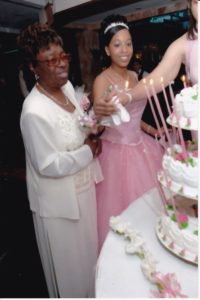My Grandmother and I: The Reason for This Space
The month of September ignites painful memories. Two years ago, my grandmother, a type-2 diabetic and double amputee declared she was tired of living. The long-term effects of type 2 diabetes ravaged her body—stealing her vision, kidney function, mobility, and will to live. Growing up witnessing her blatant defiance of doctor’s orders and insistence that as a grown woman she could eat as she pleased, I viewed her condition as a gradual death sentence. Still, I did not expect death to steal her so swiftly.

My grandmother and I at my Sweet Sixteen, shortly after my diabetes diagnosis.
In fact, three weeks before her departure, my family found ourselves teeming with relief. Following an unexpected dismissal and days of exhausting conversations, we (my mother) successfully reenrolled my grandma in her health insurance. No longer did we have to coordinate disjointed schedules to provide her 24-hour care. My grandmother could return to her thrice a week dialysis treatments and my mother could spend nights at home in her own bed. Despite this accomplishment, hope was fleeting. As ours ascended, my grandmother’s diminished.
The same week she expressed her death wish, my grandmother slid out of a contraption designed specifically for amputees. On that Friday, she endured a 5-hour wait for Access-a-Ride after her dialysis treatment. And by the next morning in the emergency room, she arrived at her breaking point, desperately waving her surrender flag. Now my grandmother casually inserted death into our weekly conversations. The thought permanently and innocently loomed over her head. But on this day, she was serious. We all knew it. The stubborn matriarch, whose independence once moved me, appeared agitated, like a fidgety child throwing a tantrum, she laid in the emergency room and cried, “Let me die.” At the end of our somber visit, we made arrangements for hospice care.
Witnessing my grandmother’s demise was terrifying. Not only did our visits remind me of her impending departure, but they also ignited fears regarding a premature, diabetes related death. Subconsciously I began to equate my own diabetes diagnosis (type 1) with mortality and doom. Anxiety consumed me. I obsessed over every too high or too low blood sugar and pondered how it would impact my future self. I broke out in tearful fits. Though my parents tried to placate me and my diabetes educator often reminded me that my condition and control were different from my grandmother’s, I found little to breathe easy about.
My grandmother’s story informs how I’ve viewed my condition as a type-1 diabetic and the choices I’ve made in living with this disease. In fact, a year into my diagnosis I wrote a candid college essay about my struggles with diabetes. I harshly (and shamefully) stated that my grandmother was “the epitome of who I did not want to be, the statistic I would not become.” For a moment, my criticism of my grandmother’s decrepit state and carpe diem management style was all the encouragement I needed to tackle diabetes. Unlike her, I promised to be diligent in my care regimen and combat my condition with a stoic resolve that warranted discipline and a proactive demeanor. At that time, I was not yet aware that despite one’s best management efforts, type 1 diabetes can be unruly and diabetes burnout is real.
In reflecting on my journey with type 1 and my grandmother’s struggles with type 2, I’ve realized that despite the differences in conditions and even our differing attitudes towards management, what I currently need (and I’m sure what she would have benefited from as well) is a community of compassionate individuals, who are willing to be candid about their own/loved ones struggles with diabetes. I need folks who don’t squint up in shame or disgust regarding other’s management woes. Instead, I seek those who provide support through example or in sharing information that has assisted them along the way.
More importantly, as an African American woman, what I find missing from this diabetes landscape is a space that showcases individuals of color triumphantly living with diabetes. I hope to introduce a counter narrative to the pervasive and dismal statistics that detail racial and ethnic minorities higher risk of complications, higher prevalence of diabetes in comparison to whites, and higher rates of death from this disease. For many of us, black or not, we are well aware of the risks that come with poor diabetes management. Reflecting on this truth can be traumatizing and debilitating. In my attempt to do away with such discouragement, this blog emerged.
Just a Little Suga’ is my personal blog, however my hope is that it will also evolve into a community space. Though not specifically reserved for black and brown diabetics, this blog will speak to my experience as one, and hopefully serve as an opportunity for others like me or those serving folks like me to connect with and support each other. In addition to sharing my story and forming relationships with other diabetics, my hope is that this space will also serve as a platform for sharing— sharing resources, encouragement, as well as advice.
I look forward to your input and support as we journey together and understand that life with diabetes is more than just a little suga’…


I saw your blog post on my cousin’s Facebook page (Abigail Lopez Byrd).
Thank you. As a type 1 myself, you are on point and burn out is real. Self advocacy has never been so important to me until now, 18 years after diagnosis and a list of fears related to long term complications. Thank you for your blog. ? Soakie
Hi Soakie! Thank you for reading and thank you for sharing. I’m glad you’ve been able to relate and I’m even more excited for your new journey towards self-advocacy. I hope you continue to find encouragement in this space.